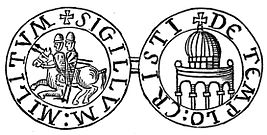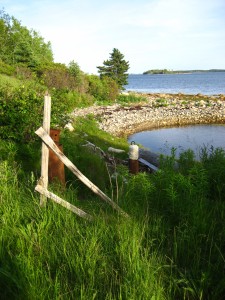The Knights Templar have been linked to the mystery of Oak Island by many, primarily because historical records suggest that they had both motive and means to deposit treasure in the Money Pit. Compelling of all is their connection with the Holy Land, prompting speculation of untold wealth in the form of the Holy Grail.
The Knights Templar were a military and religious band of men. When they formed in 1114 AD they were a small band of nine men who protected the highways of the holy land, thus allowing pilgrims to travel safely without the worry of threat from pickpockets, thieves, pirates and massive Islamic armies.

Meanwhile, St. Bernard preached about Holy War, stirring up Europe for the Crusades, causing the Templar to find themselves at the centre of religious fervour. It was not long before sons of wealthy families were pledging their fortunes and property to the order just for the privilege of joining the band.
The Templar began to emerged as the worlds first bank whereby Kings would deposit their gold in Paris only to be able to withdraw it again in Jerusalem. The result of which was the immaculate growth of Templar, in both wealth and number.
When eventually Jerusalem and the Holy Lands were lost to Islamic rule, the Templar experienced a swift backlash whereby the king of France began to plot against the organisation in hope of reaching their immense wealth.
On 13th of October 1307 the King found an ally in the Pope and ordered that the Templar be arrested. Those captured played victim to the worst tortures the medieval culture could bestow upon them, followed by being burned at the stake. The Templar grand master announced a curse on the king and pope from his final position, the stake on which he was roasted. Within one year, both would be dead.
Once the day of the arrests arrived, the Paris Templar arranged that its treasures be loaded on a wagon train headed toward the port city of La Rochelle. From there, it was deposited aboard the Templar ships, setting sail to an unknown destination. According to Andrew Sinclair, author of “The Sword and the Grail”, the Templar were said to flee with the treasure to Scotland.
It was in Scotland that they founded the St. Clair family, later to be known as Sinclair. The Sinclair’s built Rosslyn Chapel, an often cited link between the Temple and Freemasonry. This chapel becomes temporarily the resting place of the legendary Holy Grail before its final journey to Nova Scotia, (a site currently enjoying increased fame due to the success of the popular Dan Brown novel, The Da Vinci Code).
The Sinclair’s became the Grand Masters of the order and desired a new land in which to establish their utopian Templar government. Using both their money and military strength coupled with the sailing abilities of the Zeno’s, they sailed westwards towards Nova Scotia.
The arrival of the Knights Templar in this region is supported by a Zeno narrative and map attributed to Vopell and Vavassatore. It depicts the landmass of Nova Scotia or New Scotland with the figure of a crowned knight. Further evidence exists of visitors in New England, in the form of the Tower in Newport, Rhode Island and, the Westford Knight, a carving of the figure of an armoured, European knight holding a cruciform sword, a common Templar emblem on graves.

Once the unsuccessful colony of the Temple died out, instead of sailing back east, the American Templar decided to hide the bounty. They built a complex ‘Money Pit’ on Oak Island by engineering flood traps to prevent anyone reaching the treasure. The spot is marked using the form of a stone cross, symbolism typical of the Templar.
Evidence exists to support the Templar’s involvement in the Oak Island Money Pit, but to expand this theory further, it would be useful to consider the influence of the Freemasons in this area, as the Templar were a precurser for this select group of individuals. There remains a strong connection to this area with the Knights Templar, whether relative to the treasure or not and further study may shed light on the mystery.